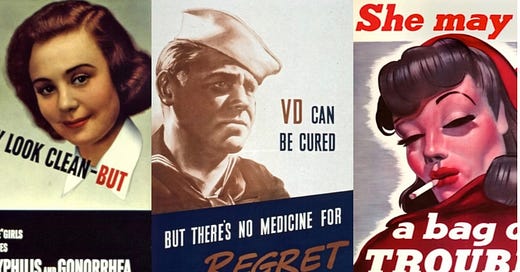How do you tell your 19-year-old son to practice safe sex without telling him to practice safe sex?
Well, here is Árpád Gerbner’s brilliant and very scholarly method.
In his letter from April 1939, when Opapa was in Paris — on his way to America — Árpád added a postscript:
I believe that Polonius – behind the scenes – did not forget to warn Leartes about the significant role condoms played in world history or at least in the history of health.
If you realized that Árpád is referring to Shakespeare’s Hamlet to tell his son to take precautions, well done.
Árpád is referring to Act 1 Scene 3 of Hamlet, in which Ophelia and Laertes are in their father Polonius’s house. Laertes is lecturing his sister Ophelia about chastity, and warning her not to trust Hamlet. She responds by calling him a “libertine”:
But, good my brother,
Do not — as some ungracious pastors do —
Show me the steep and thorny way to heaven,
Whilst, like a puffed and reckless libertine,
Himself the primrose path of dalliance treads,
And recks not his own rede.
In some productions, they have actually shown Ophelia finding condoms in Laertes’ suitcase, showing that he is being hypocritical when he tells Ophelia to stay away from Hamlet.
Polonius then enters, and offers his advice, which include the famous lines, “to thine own self be true.” Polonius also tells Laertes to behave himself when he is in France.
Árpád understood the implication of the scene, and he knew his son would as well. Opapa, like Laertes, was going to France.
Árpád didn’t stop there, though. He added some cultural history:
I hope you know that the Italian call syphilis the “French disease”, while the French call it the “Italian disease”
Indeed, syphilis is also called the “German disease” by the Poles, and the “Polish disease” by the Russians. Árpád would probably be interested to know that there’s been fascinating new research on the history of syphilis as well. For many years, historians believed that syphilis was the only disease that moved from the Americas to Europe during what is called “The Columbian exchange” (ie the massive exchange of foods, animals, germs, and disease that occurred during the colonization of the Americas, after 1492). But recently, researchers have shown that some of the skeletons of people buried under Pompeii and Herculaneum showed signs of syphilis. If he had known, I imagine Árpád might have connected his advice with the fall of Rome.
I love these letters, not only because unearthing all of Árpád’s references is like a treasure hunt, but also because as a parent, I increasingly identify with Árpád’s anxieties and efforts to articulate a “warning” without being too overbearing or explicit.
I can also imagine 19-year-old Opapa receiving this letter in Paris, en route to America. He was spending his days trying to sort out his visa and his ticket to Mexico, but he probably had a lot of down time as well. I wonder if Opapa rolled his eyes when he read this, or whether he smiled at his father’s elaborate way of offering fatherly advice.
Either way, warnings about syphilis were widespread in the 1930s and 40s, and Opapa was surely reminded of his father’s warnings when he saw any one of these posters, which were mass produced and aimed at American soldiers during World War II.
As Árpád concluded in his letter to Opapa: “Therefore: do not joke about this matter.”
***
Nuts to crack:
What was Opapa doing in Paris, and how long was he there? I know he missed the first oceanliner he was supposed to go on because he hadn’t received his visa yet.





Family lore says the SS Normandie. But see if you can verify that. We all like imagining a penniless immigrant living it up on a gorgeous ship (though he was refused entry to the US from the ship. Hope it’s true!)
All I know is that he had cousins living in Paris who were going to buy his ticket. So he was headed there to emigrate. And GEorge told us the only available ticket was a first class cabin -- and subsequently we realized that it was a famous ship with gorgeous art nouveau interiors that was later dismantled-- maybe to outfit a troop ship?